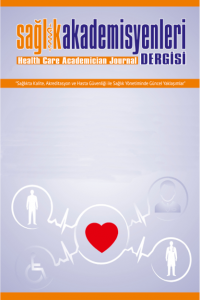Ovaryan endometrozis ve D vitamini düzeyi arasındaki ilişki
OVARYAN ENDOMETROZİSDE D VİTAMİNİ DÜZEYLERİ ÖZET Giriş ve Amaç: D vitamininin endometriozis patogenezindeki potansiyel rolü araştırmacılar tarafından üzerinde çalışılan bir konudur. Bu çalışma, endometriozisin çeşitli özellikleri ile D vitamini düzeyleri arasındaki ilişkiyi araştırmak amacıyla yapılmıştır. Gereç Yöntemler: Katılımcıların sosyodemografik özellikleri olarak yaş, parite ve sigara içme değişkenleri incelendi. Çalışmamızda incelenen diğer değişkenler evre, anti-Müllerian hormon ve D vitamini düzeyleri, endometriozisin, sağda veya solda, görüldüğü taraf, endometriozisin yaygınlığı ve infertilite durumudur. Tanımlayıcı istatistiksel yöntemler, korelasyon analizi, regresyon analizi, bağımsız örnekler t testi ve tek yönlü varyans analizi kullanılmıştır. Bulgular: Korelasyon analizine göre kandaki D vitamini düzeyi ile evre arasında istatistiksel olarak anlamlı, orta düzeyde bir ilişki vardır. Regresyon modeline göre kandaki D vitamininin evre üzerinde olumsuz ve anlamlı bir etkisi vardır. Bu bulgulara göre D vitamini seviyesindeki düşüşün hastanın evre durumunu yükselteceği söylenebilir. Sonuç: Araştırmanın birincil konusu olan D vitamini ile endometriozis arasındaki ilişki üç farklı istatistiksel yöntemle araştırıldı.
Anahtar Kelimeler:
Endometriozis, D Vitamini, Anti-Müllerian Hormon, Parite, Sigara, İnfertilite.
The relationship between ovarian endometrosis and vitamin D level
ABSTRACT Introduction & Aim: The potential role of vitamin D in the pathogenesis of endometriosis is a subject that has been studied by researchers. This study was carried out to investigate the correlation between various features of endometriosis and vitamin D levels. Material Methods: Age, parity and smoking variables of the participants were examined as socio-demographic characteristics. Other variables examined in our study are stage, anti-Müllerian hormone and vitamin D levels, the side where endometriosis is seen, either right or left, the extent of endometriosis and infertility status. Descriptive statistical methods, correlation analysis, regression analysis, independent samples t-test and one-way analysis of variance were used. Results: According to the correlation analysis, there is a statistically significant, moderate relationship between the level of vitamin D in the blood and the stage. According to the regression model, vitamin D in the blood has a negative and significant effect on the stage. According to these findings, it can be said that the decrease in vitamin D level will increase the stage status of the patient. Conclusions: The correlation between vitamin D and endometriosis, which is the primary subject of the research, was investigated with three different statistical methods.
Keywords:
Endometriosis, Vitamin D, Anti-Mullerian Hormone, Parity, Smoking, Infertility.,
___
- 1. Chapron C, Marcellin L, Borghese B, Santulli P. (2019) Rethinking mechanisms, diagnosis and management of endometriosis. Nat Rev Endocrinol, 15(11):666–82.
- 2. Czyzyk A, Podfigurna A, Szeliga A, Meczekalski B. (2017) Update on endometriosis pathogenesis. Minerva Ginecol, 69(5):447–61.
- 3. Sizar O, Khare S, Goyal A, Bansal P, Givler A. (2022).Vitamin D Deficiency. StatPearls [Internet]. Treasure Island (FL): StatPearls Publishing.
- 4. Kalaitzopoulos DR, Lempesis IG, Athanasaki F, Schizas D, Samartzis EP, Kolibianakis EM, et al. (2020) Association between vitamin D and endometriosis: a systematic review. Hormones (Athens), 19(2):109–21.
- 5. Han SJ, O’Malley BW. (2014) The dynamics of nuclear receptors and nuclear receptor coregulators in the pathogenesis of endometriosis. Hum Reprod Update, 20(4):467–84.
- 6. Harris HR, Chavarro JE, Malspeis S, Willett WC, Missmer SA. (2013) Dairy-food, calcium, magnesium, and vitamin D intake and endometriosis: a prospective cohort study. Am J Epidemiol, 177(5):420–30.
- 7. Giampaolino P, Della Corte L, Foreste V, Bifulco G. (2019) Is there a Relationship Between Vitamin D and Endometriosis? An Overview of the Literature. Curr Pharm Des, 25(22):2421–7.
- 8. Chauhan K, Shahrokhi M HM. (2021) Vitamin D. StatPearls. Treasure Island (FL): StatPearls Publishing.
- 9. La Marca A, Spada E, Grisendi V, Argento C, Papaleo E, Milani S, et al. (2012) Normal serum anti-Müllerian hormone levels in the general female population and the relationship with reproductive history. Eur J Obstet Gynecol Reprod Biol,163(2):180–4.
- 10. American Society for Reproductive Medicine. (1996) Revised American Society for Reproductive Medicine classification of endometriosis:. Fertil Steril,67(5):817–21.
- 11. Esinler I, Bozdag G, Arikan I, Demir B, Yarali H. (2012) Endometrioma ≤3 cm in Diameter per se Does Not Affect Ovarian Reserve in Intracytoplasmic Sperm Injection Cycles. Gynecol Obstet Invest,74(4):261–4.
- 12. La Marca A, Spada E, Grisendi V, Argento C, Papaleo E, Milani S, et al. (2015) Maternal age and risk of labor and delivery complications. Matern Child Health J,19(6):1202–11.
- 13. Ciavattini A, Serri M, Delli Carpini G, Morini S, Clemente N. (2017) Ovarian endometriosis and vitamin D serum levels. Gynecol Endocrinol, 33(2):164–7.
- 14. Derakhshan M, Derakhshan M, Hedayat P, Shiasi M, Sadeghi E. (2018) Vitamin D deficiency may be a modifiable risk factor in women with endometriosis. Crescent J Med Biol Sci, 5(4):292–6.
- 15. Qiu Y, Yuan S, Wang H. (2020) Vitamin D status in endometriosis: a systematic review and meta-analysis. Arch Gynecol Obstet,302(1):141–52.
- 16. Tanni SE, Patino CM, Ferreira JC. (2020) Correlation vs. regression in association studies TT - Correlação vs. regressão em estudos de associação. J Bras Pneumol,46(1):e20200030.
- 17. Garavaglia E, Sala C, Taccagni G, Traglia M, Barbieri C, Ferrari S, et al. (2017) Fertility Preservation in Endometriosis Patients: Anti-Müllerian Hormone Is a Reliable Marker of the Ovarian Follicle Density. Front Surg,25; 4:40.
- 18. Al-Fozan H, Tulandi T. (2003) Left lateral predisposition of endometriosis and endometrioma. Obstet Gynecol,101(1):164–6.
- ISSN: 2148-7472
- Yayın Aralığı: Yılda 4 Sayı
- Başlangıç: 2014
- Yayıncı: Dünya Kongre
Sayıdaki Diğer Makaleler
Ovaryan endometrozis ve D vitamini düzeyi arasındaki ilişki
Ozlem GURSOY, Ceren YILDIZ EREN, Hulusi Göktuğ GÜRER
Televizyon Reklamları: Çocukluklarda Obezite ve Besin Seçimine Etkileri
COVİD 19 SÜRECİNDE YAPAY ZEKÂ VE BİLEŞENLERİ İLE İLGİLİ YAYINLARIN BİBLİYOMETRİK ANALİZİ
Tuğçe KARAYEL, Mehmet Nurullah KURUTKAN
Konjenital kalp hastalığı olan çocuklarda aile merkezli bakımın önemi
Sağlık Çalışanlarının Örgütsel Etik İklim Algısı
Gülay YAZICI, Dilek AKTAŞ, Sema KOÇAŞLI, Hülya BULUT, Kübra YILMAZ
Dijital Hastane Modelinin Gerçekleşmesi Bağlamında Mobil Cihazların Sağlık Turizmi Alanındaki Rolü
Kadınların serviks kanseri erken tanısına yönelik farkındalık durumlarının belirlenmesi
